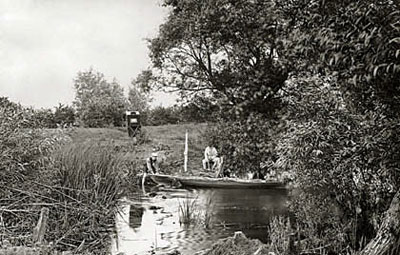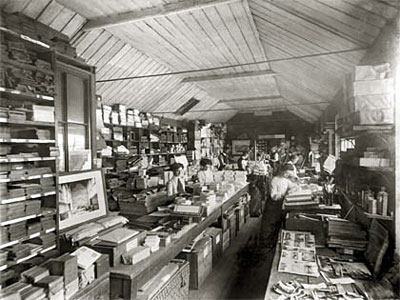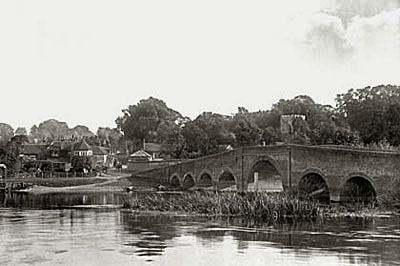| home |
the project |
henry taunt |
photographs |
the book |
exhibition |
authors |
partners |
images |
maps |
| Photographs |
|
Graham with Phase One camera system
|
 |
|
Jeff & Graham with Phase One camera system at Abingdon
|
 |
|
Sonning Bridge c1885
Taunt's original photograph |
|
|
Sonning Bridge which Taunt enhanced with clouds double printed from
another photo
c 1885 |

|
|
Henry Taunt on location with his portable dark tent, at Ham Weir c1863
|

|
|
Henry Taunt's Handicraft Room at Rivera, Oxford where staff assembled
the guides
post 1889-1914 |

|
The Making of 'The River Thames Revisited'
There is an interesting parallel between the way wet collodion technology swept away the daguerreotype and calotype in the 1850s and the way digital imaging has been replacing film technology in the last decade.
Photography in the 21st Century:
In early 1999, Phase One, a company that make high-resolution digital backs for professional
cameras, announced their new location solution for the Lightphase, 6 million pixel digital
back, which could be run off video camera batteries rather than mains power. Only a few portable
units would initially be coming to the UK. After only a little cajoling, we convinced Phase One that a really
good field test was required. Photographing the Thames digitally 'in the footsteps of Henry Taunt', was the
perfect project. One of the units fell into our hands for five weeks during the summer of 1999. We were also
loaned a very fast Vaio laptop by Sony UK. We needed this as the digital back had to be linked to software to
work. By the autumn we had taken what may well have been (then) the highest resolution digital landscape
pictures in the world. In October 2006 we shot the last two images. These were of Staines Bridge and Chertsey
Bridge. By this time technology had moved on and our new Leaf camera had a 17 million pixel
back and its own screen to control the image, so we no longer need a laptop.
Photography in the 19th Century
When Henry Taunt was born in June 1842, photography had been announced less than three years earlier, both by Louis Daguerre in Paris and William Henry Fox Talbot in London. Each man had experimented for much of the 1830s, but worked completely oblivious of each other’s existence.
The chemistry involved in both inventions involved fairly life-threatening concoctions. In a happy accident around 1835, Louis Daguerre, discovered that mercury fumes would amplify an under-exposed ‘latent’ image into a successful picture. Experiments with the Fox Talbot Calotype process involved processing paper negatives in the relatively innocuous gallic acid, the lethal pyrogallic acid and attempts to fix images in hot common salt. The famous English scientist, Sir John Herschel suggested ‘hyposulphate of soda’ and ‘Hypo’ remained the nickname for fixer until the latter part of the 20th century. Many could see the advantages of the negative/positive system, but if only clear glass could be used instead of paper. Silver bromide is like cottage cheese so imagine trying to coat that evenly onto glass and one can understand their problem. Albumen was tried but around 1849. Fredrick Scott Archer (1813-57), a sculptor, who had learned the Calotype process to record some of his portrait busts, started experimenting with collodion, photographic emulsions and glass plate negatives. He published his results in ‘The Chemist’ magazine early in 1851. However the downside was still the difficulty in spreading the collodion evenly and that it had to be sensitised, exposed and developed while still wet. Once it began to dry, the sensitivity was lost and developing chemicals could not penetrate the surface.
Many of Taunt’s surviving prints are a very warm chocolate brown colour. This could be achieved in one of two ways, either by using silver chloride, which gives a much warmer tone, or by sepia toning where the black silver image is replaced by warm brown silver sulphide. Many Victorian photographers experimented with both techniques, partially because warm images were fashionable and therefore more saleable and partially because there was a perception that sepia toning would prevent the image from fading.
Wet collodion continued to be the best means to capture negative images on glass until the end of the 1870s, by which time many of Taunt’s pictures for his ‘Illustrated Map of the Thames’ had been taken. He would row his skiff to a location, set up his dark tent, set up his camera and tripod, sensitise and coat the glass plate, immediately make the two or three second exposures, develop and fix the images, wash them in river water, perhaps dry them in the sun and row back to his lodgings or set up camp with his assistants. Certainly at the beginning of the 1860s this was an incredible feat of skill and Henry Taunt was truly at the cutting edge of Victorian location photographic technology.
Taunt’s photographs were key to this project.
English Heritage and Oxfordshire County Council now hold the majority of Taunt’s surviving images, over 13,000 negatives and prints, in secure archive conditions. Both organizations were exceptionally helpful in locating all of the images that we needed. By 2002, we were able to offer our photo essay of “In the footsteps of Henry Taunt” to English Heritage as a story for their ‘Viewfinder’ website, where it can still be seen today along with other images of Oxfordshire County Council.
Seventy-five of Taunt's original images were digitised and then carefully restored, using the latest image manipulation techniques to return them to their original quality to form part of this project.
Graham Diprose & Jeff Robins, November 2007


